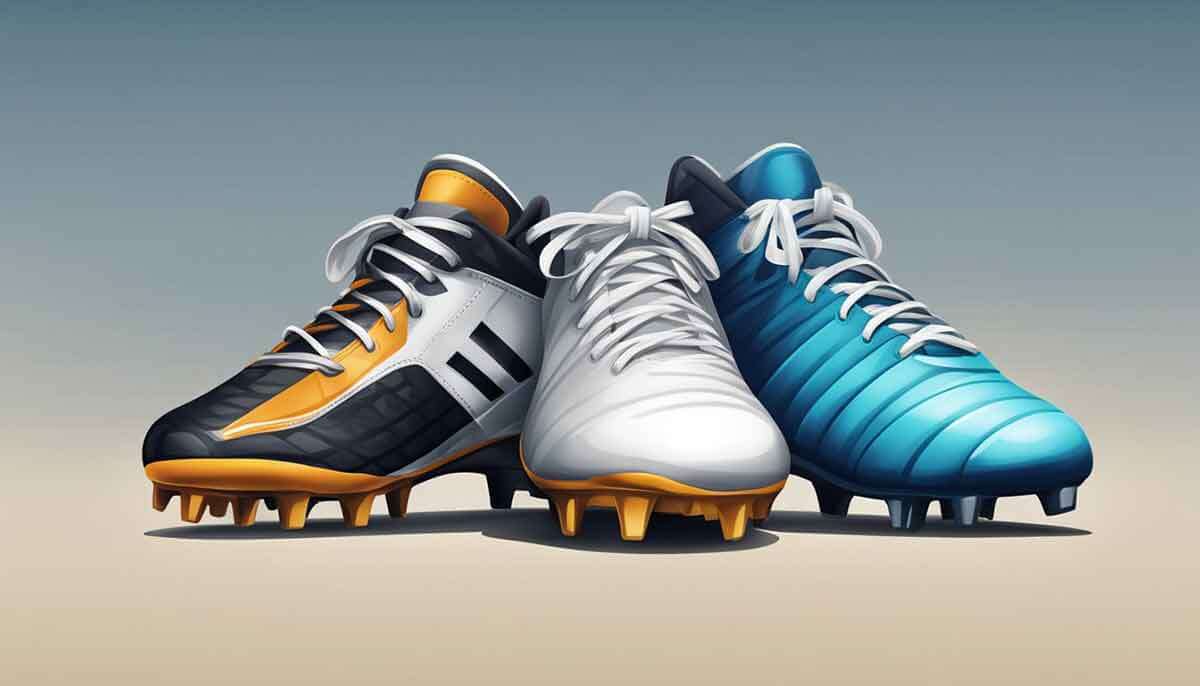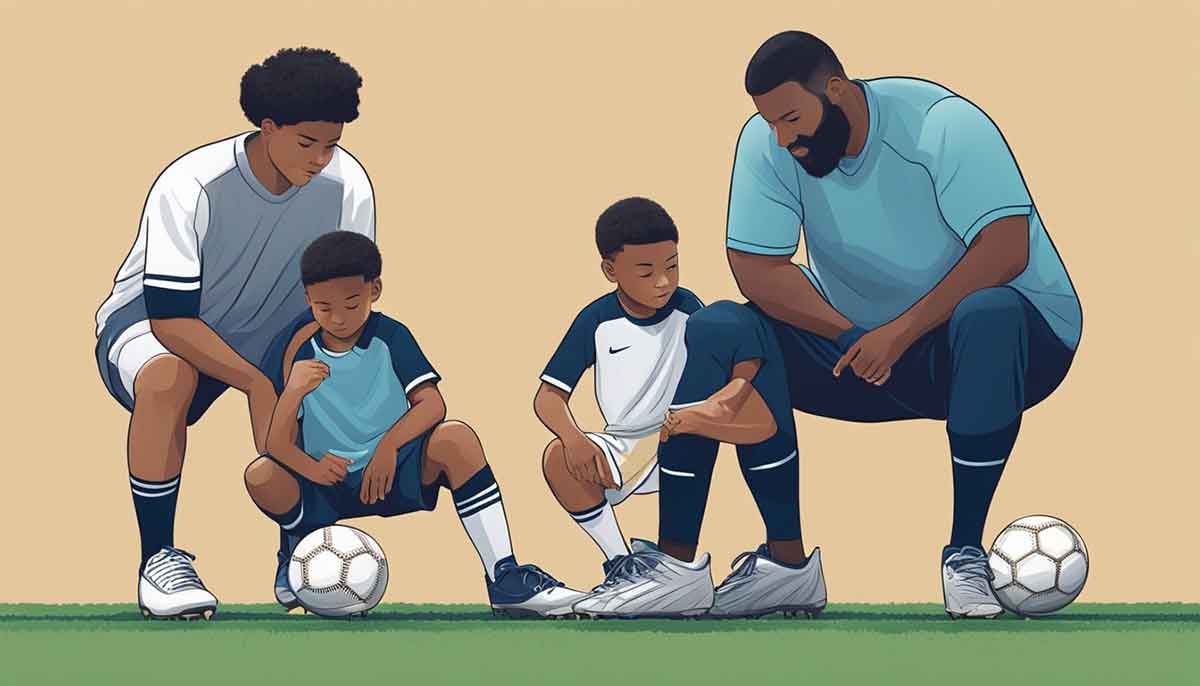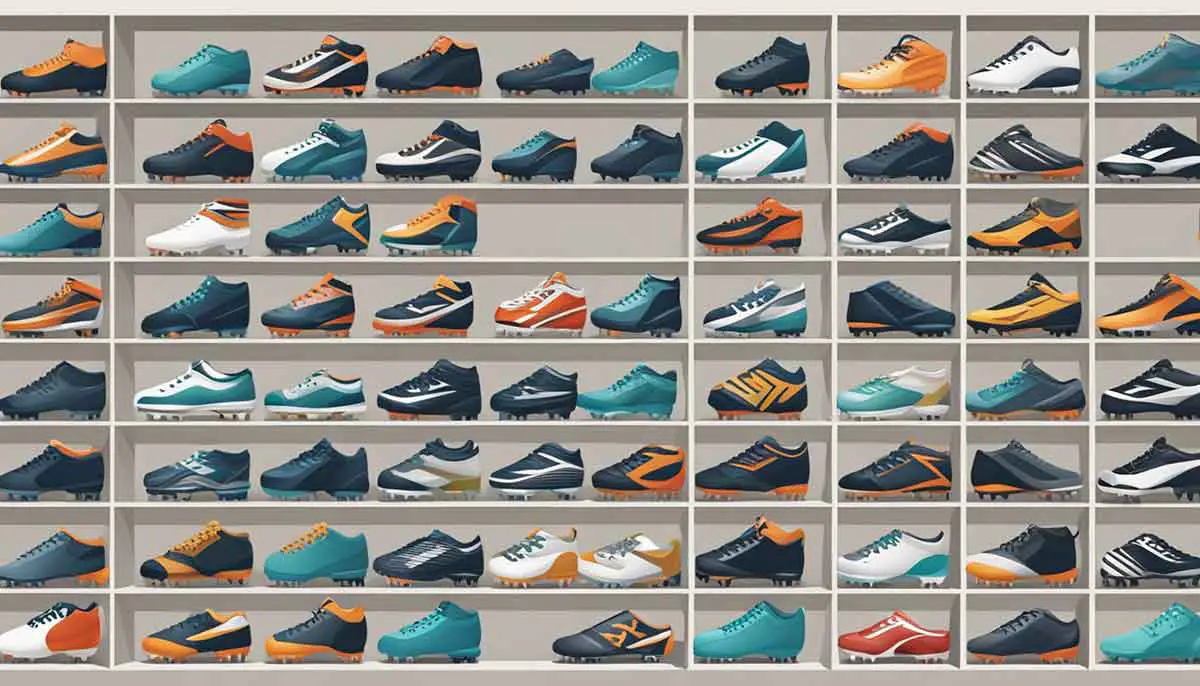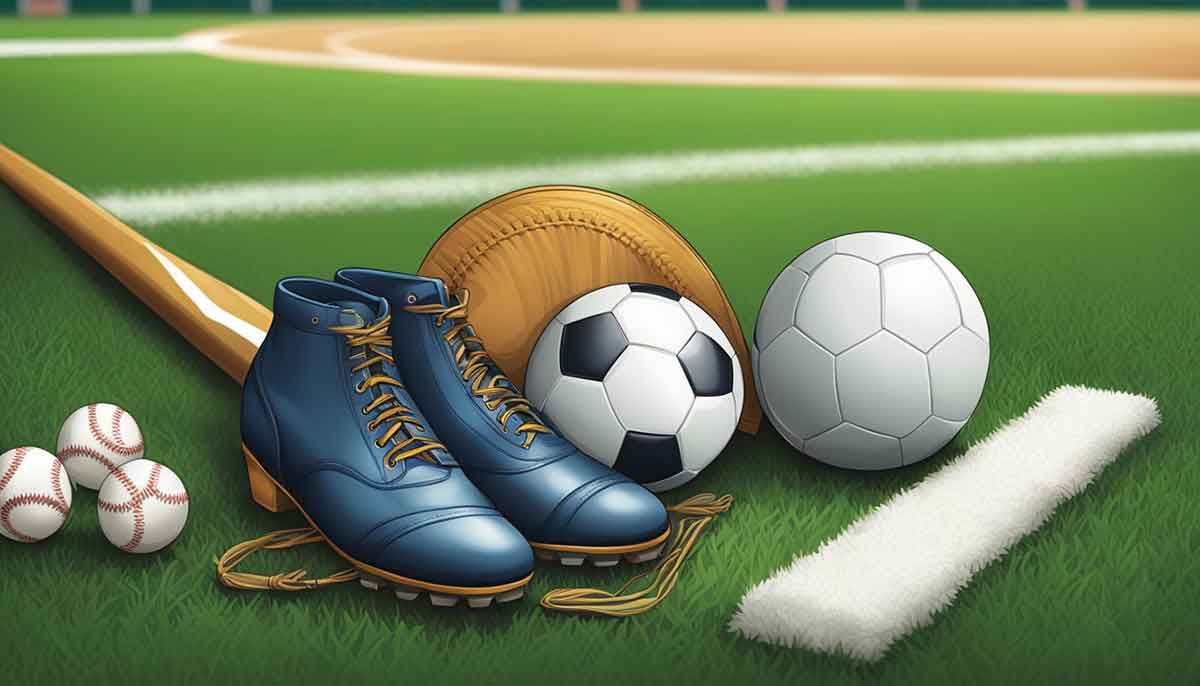Athletes across all sports understand that the right equipment is crucial for optimal performance, safety, and comfort on the field. For soccer and baseball players, especially, this includes not just the uniform and protective gear but extends to the very cleats on their feet.
One common query that players and parents alike often wrestle with is the differences between soccer and baseball cleats and whether these types of footwear are interchangeable. The answer isn't straightforward:
Soccer cleats are designed to maximize agility and control, featuring low-profile studs for rapid movement. In contrast, baseball cleats often include a toe spike for enhanced traction during running, alongside varying stud patterns tailored for the diamond's unique challenges.
However, there's more beneath the surface of this comparison. This article dives deep into every aspect you need to know.
Key Takeaways
- Soccer and baseball cleats are designed with specific features that cater to the unique demands of each sport.
- Interchanging cleats between soccer and baseball can impact performance, safety, and adherence to league regulations.
- Understanding the structural and functional differences of these cleats is essential for making the right choice for young athletes involved in multiple sports.
- Parents and players need to consider factors such as league rules, the potential for injury, and the effects of cleat design on gameplay when selecting footwear.
Understanding and Comparing Soccer and Baseball Cleats
Selecting the right cleats is more than a fashion statement—it's a game-changer.
Soccer and baseball cleats are designed with their unique sport in mind, significantly influencing your performance by catering to each sport's specific movements and requirements.
Key Design Differences and Their Impact on Performance
The build of your cleats plays a pivotal role in how you maneuver on the field.
Soccer cleats are engineered for finesse, offering lightweight construction that optimizes quick footwork and ball control.
On the flip side, baseball cleats provide extra features for explosive movements. Metal spikes, although heavier, ensure exceptional grip during dynamic plays but come with restrictions in younger leagues for safety reasons.
- Soccer Cleats: Focus on control and agility.
- Baseball Cleats: Ensure stability for swift changes in direction.
Material and Build: Metal vs. Mold Cleats
Cleats come in two main types: metal and molded.
Soccer leans towards molded cleats, crafted from rubber or plastic, to adapt across various types of pitches.
Baseball players might opt for metal cleats for their superior traction and stability, albeit at the expense of greater weight and potential discomfort.
- Soccer Cleats: Rubber or plastic for flexibility across surfaces
- Baseball Cleats: Metal for unparalleled grip
Cleat Pattern, Shape, and Sole Plate Variations
Every detail, down to the cleat pattern, matters.
Soccer cleats feature evenly spaced studs for consistent performance and touch, while baseball cleats deploy diverse stud arrangements to enhance propulsion and support dynamic plays.
The studs' design—size and shape—are tailored to each sport, with soccer prioritizing numerous, compact studs for optimal pitch contact.
- Soccer Cleats: Designed for balance and refined movement
- Baseball Cleats: Aimed at delivering robust traction
The Role and Risks of the Toe Cleat in Baseball Cleats
A notable feature in baseball cleats is the extra toe stud, a boon for base-stealing but a potential risk on the soccer field. This protrusion can lead to injuries during soccer's common rapid directional changes and high kicks.
- Extra Toe Stud: A double-edged sword; valuable in baseball but risky for soccer
Ankle Support: Soccer vs. Baseball Cleats
Your choice also hinges on the desired balance between ankle support and mobility.
While soccer cleats typically sport a low-cut design for unhampered movement, baseball cleats may opt for a mid-top style, providing additional support beneficial during quick turns and lateral movements.
- Soccer Cleats: Low-cut for maximum agility
- Baseball Cleats: Mid-top for strategic ankle support
Choosing the right cleats isn't just about preference—it's about performance. Armed with these insights, you're better equipped to make a decision that could very well elevate your game.
Remember, the devil is in the details, and in sports, those details can be the difference between good and great.
Can You Use Soccer Cleats for Baseball and Vice Versa?

Deciphering when it's permissible to swap cleats between soccer and baseball isn't just about convenience; it's an intricate blend of adhering to regulations and navigating practicality.
Let’s understand the interchangeability of soccer and baseball cleats across the pitch.
Rules and Regulations Surrounding Cleat Usage
Before you lace up soccer cleats for a baseball match or vice versa, it's critical to familiarize yourself with your league's regulations concerning footwear.
The fine print of these rules can significantly influence your decision, as flouting them might lead to penalties or, worse, jeopardize your team's standing.
When Might Baseball Cleats Be Used for Soccer? And Vice Versa
- Soccer Prospects: Considering baseball cleats might be tempting for soccer players facing a match on saturated, slippery terrains, where the toe stud's extra grip could prove beneficial.
- Baseball Bound: On the other side, soccer cleats may find a place in the baseball diamond, especially among younger enthusiasts. Here, the game's demands are less exacting, and the cleats' design differences become less impactful.
Problems and Drawbacks of Interchangeable Use
Using cleats interchangeably might seem like a clever hack, but it's not without its issues:
- Incorrect cleat choices can lead to accelerated field damage.
- Ill-suited cleats often fail to offer necessary support and comfort, raising the odds of blisters or ankle injuries.
- Employing baseball cleats in soccer poses a risk to others due to the protruding toe stud, which is not only illegal but dangerous during close encounters.
Referee and League Discretion on Cleat Choice
In the end, the referees and your league's guidelines are decisive in what cleat choices pass muster:
- Prioritize discussions with your coach or officials to ensure you're in the clear, eliminating any pre-game uncertainties.
- While informal play might welcome any cleat in good spirit, formal competitions will likely mandate sport-specific footwear to uphold both safety and fairness.
Why Choosing the Right Cleats Matters

The decision on which cleats to wear isn't just about completing your kit; it's a strategic choice that significantly impacts your game dynamics, safety on the field, and overall comfort during play.
Here’s why making the right choice is non-negotiable.
Performance Impact and Injury Prevention
The type of cleats you don defines not just how you perform but also your risk exposure to injuries.
With baseball cleats, the toe cleat designed for sprinting can be a liability on the soccer pitch, where it may interfere with the fluid lateral moves and quick direction changes, increasing the risk of trips or falls.
The toe cleat also increases the danger for other players, given the frequent high kicks in soccer.
It's important to recognize that soccer enforces strict safety protocols to safeguard its athletes, emphasizing the importance of appropriate attire, especially concerning footwear.
IFAB’s Law 4 – The Player's Equipment outlines the critical criteria for safe attire, including the necessity of wearing suitable footwear for the game.
Soccer cleats are built for agility, balancing traction with the need for speed, and come equipped with cushioned insoles for enduring comfort across varying field conditions.
*Note: IFAB (International Football Association Board) supervises the laws for the game of association football.
Handling the Soccer Field with Baseball Cleats
Bringing baseball cleats onto the soccer field can feel like steering a race car on a rally track—an uneasy fit that could hamper your game play.
That front toe spike, optimized for base running, can become a snag on the soccer field, where agility trumps raw traction.
Not to mention, the metal spikes found on some baseball variants can be harsh on the more forgiving soccer terrains, risking both field integrity and your own mobility.
Safety Concerns and Performance Issues When Wearing Soccer Cleats for Baseball
Venturing onto the baseball diamond in soccer cleats can leave you feeling under-geared.
The lack of a toe cleat might leave you scrambling for grip during those crucial base runs, increasing the likelihood of slips and slides.
The lighter, synthetic fiber or plastic spikes of soccer cleats may not stand up to the demands of the hard dirt of the baseball diamond, potentially compromising both stability during pivotal moments and your overall performance.
Special Considerations for Youth Athletes and Parents

Choosing cleats for young athletes isn't just about picking the right color or following the latest trends. It's a critical decision that affects their comfort, gameplay, and risk of injury.
Here, we dig into the key considerations for parents navigating this essential gear choice for their aspiring superstars.
Important Factors to Consider When Purchasing Cleats for Young Players
When shopping for youth cleats, the focus should be on fit, comfort, and adapting to growing feet.
Opt for designs that offer ample cushioning for impact absorption and durability to endure the rough and tumble of sports.
A perfect fit is crucial for immediate support, but don't forget to leave a smidge of room—a nod to the inevitable growth spurts.
The Issue of Using Football or Softball Cleats in Soccer and Baseball
It’s vital for young athletes and their parents to recognize the distinctions in their sports equipment.
Soccer cleats, designed without a toe stud, minimize the risk of injury from high-impact moves, making them a safer option for aspiring soccer stars.
Baseball cleats feature an extra toe cleat for bursts of speed but pose a risk on the soccer field.
Steering clear of football cleats or softball cleats for soccer and baseball usage is smart, as these aren't tailored for the nuanced demands of either sport.
Advice for Parents on Choosing Cleats for Multiple Sports
For the multi-sport athlete, the cleat conundrum can be even more daunting.
While the ideal scenario involves sport-specific cleats to maximize performance and safety, practicality and budget often dictate a different approach.
In such cases, soccer cleats emerge as a versatile choice suitable for various turf sports, thanks to their universal design and safety features.
However, it's crucial to verify league policies on cleat use across sports, ensuring your young athlete can stride onto any field with confidence and compliance.
Navigating Exceptions and Special Cleat Designs for Versatile Athletes

For young athletes dipping their toes in both soccer and baseball, understanding the specific demands of each sport's footwear is key to both optimizing performance and ensuring safety.
Here's a closer guide to maneuvering through the world of sports cleats, especially tailored for those who shine in more than one arena.
Regulatory and League Rules on Cleat Usage in Youth Sports
The rules surrounding cleat usage in youth sports are primarily devised with safety in mind:
- For Baseball Aspirants: Youth leagues typically set a ban on metal cleats to avert injuries, encouraging the use of plastic or rubber alternatives for safer play.
- Soccer Protocols: The norm here leans towards plastic or rubber cleats as well, firmly excluding metal options to maintain the safety and integrity of the play.
Always verify with your specific league's rules to ensure your gear is up to par and permissible for play.
Special Soccer and Baseball Cleat Designs for Versatile Athletes
For those navigating the transition between soccer and baseball, certain cleat designs cater specifically to your versatile sporting needs:
- Hybrid Cleats: Ingeniously designed to marry soccer's need for speed and agility with baseball's requirement for steadfast traction, these cleats are a godsend for multi-sport athletes.
- Interchangeable Cleats: Offering the ultimate in versatility, these cleats allow athletes to switch studs as they switch sports, ensuring perfect preparation for any game.
While these adaptable options exist, confirming their compliance with the sport-specific regulations and functionality is essential.
Tips for Safe Usage of Baseball Cleats in Soccer

Venturing from the baseball diamond to the soccer field with the same pair of cleats poses its challenges. Here are some tips to ensure a safe and smooth transition:
- Inspect the Cleat Design: Be aware that traditional baseball cleats come with an extra toe stud, a feature that could sideline you in soccer due to safety regulations.
- Opt for Soccer-Specific Footwear: When in doubt, choosing cleats designed explicitly for soccer helps avoid any compliance or safety mishaps, ensuring you're always game-day ready.
- Prioritize Fit and Comfort: Above all, ensuring your cleats fit well and provide comfort is crucial in preventing injuries, no matter the sport you're playing.
FAQ: Frequently Asked Questions
What are the differences between baseball cleats and soccer cleats?
The main distinction lies in the design focus: Baseball cleats have a toe spike for improved traction during base running, a feature absent in soccer cleats, which prioritize low-profile studs for enhanced agility and fluid lateral motions.
What sets soccer cleats apart from baseball ones in design and function?
Soccer cleats are finely tuned for speed and agility, featuring evenly distributed studs that allow for swift direction changes. In contrast, baseball cleats provide additional ankle support and include a toe spike to accommodate the sport's quick sprints and sudden takeoffs.
How do the spike configurations differ between soccer and baseball cleats?
Soccer cleats generally boast a consistent stud pattern with shorter cleats to aid in rapid pivoting. Baseball cleats display a unique stud array, emphasizing a toe spike specifically designed to boost quick movements and stability during play.
What should I consider when choosing between soccer and baseball cleats for my child?
Key considerations should align with the sport's demands: Soccer necessitates footwear that supports swift, agile movements, whereas baseball cleats are chosen for their ability to provide optimal traction and stability during dynamic play phases such as running to bases or batting.
Is it safe to wear baseball cleats while playing soccer?
Due to the toe spike found on baseball cleats, they pose a safety risk in soccer's close-contact environment, increasing the likelihood of injury during play. Thus, they are not recommended for soccer.
Can wearing baseball cleats impact performance on the soccer field?
Wearing baseball cleats on the soccer field potentially diminishes your on-field performance, as their bulkier design and toe spike may restrict the precise and quick footwork essential in soccer.

